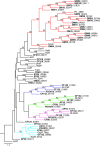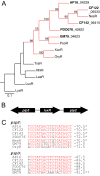LuxR- and luxI-type quorum-sensing circuits are prevalent in members of the Populus deltoides microbiome
- PMID: 23851092
- PMCID: PMC3754149
- DOI: 10.1128/AEM.01417-13
LuxR- and luxI-type quorum-sensing circuits are prevalent in members of the Populus deltoides microbiome
Abstract
We are interested in the root microbiome of the fast-growing Eastern cottonwood tree, Populus deltoides. There is a large bank of bacterial isolates from P. deltoides, and there are 44 draft genomes of bacterial endophyte and rhizosphere isolates. As a first step in efforts to understand the roles of bacterial communication and plant-bacterial signaling in P. deltoides, we focused on the prevalence of acyl-homoserine lactone (AHL) quorum-sensing-signal production and reception in members of the P. deltoides microbiome. We screened 129 bacterial isolates for AHL production using a broad-spectrum bioassay that responds to many but not all AHLs, and we queried the available genome sequences of microbiome isolates for homologs of AHL synthase and receptor genes. AHL signal production was detected in 40% of 129 strains tested. Positive isolates included members of the Alpha-, Beta-, and Gammaproteobacteria. Members of the luxI family of AHL synthases were identified in 18 of 39 proteobacterial genomes, including genomes of some isolates that tested negative in the bioassay. Members of the luxR family of transcription factors, which includes AHL-responsive factors, were more abundant than luxI homologs. There were 72 in the 39 proteobacterial genomes. Some of the luxR homologs appear to be members of a subfamily of LuxRs that respond to as-yet-unknown plant signals rather than bacterial AHLs. Apparently, there is a substantial capacity for AHL cell-to-cell communication in proteobacteria of the P. deltoides microbiota, and there are also Proteobacteria with LuxR homologs of the type hypothesized to respond to plant signals or cues.
Figures



Similar articles
-
Whole genome sequencing and analysis reveal insights into the genetic structure, diversity and evolutionary relatedness of luxI and luxR homologs in bacteria belonging to the Sphingomonadaceae family.Front Cell Infect Microbiol. 2015 Jan 8;4:188. doi: 10.3389/fcimb.2014.00188. eCollection 2014. Front Cell Infect Microbiol. 2015. PMID: 25621282 Free PMC article.
-
An evolving perspective on the Pseudomonas aeruginosa orphan quorum sensing regulator QscR.Front Cell Infect Microbiol. 2014 Oct 28;4:152. doi: 10.3389/fcimb.2014.00152. eCollection 2014. Front Cell Infect Microbiol. 2014. PMID: 25389523 Free PMC article. Review.
-
A LuxR Homolog in a Cottonwood Tree Endophyte That Activates Gene Expression in Response to a Plant Signal or Specific Peptides.mBio. 2016 Aug 2;7(4):e01101-16. doi: 10.1128/mBio.01101-16. mBio. 2016. PMID: 27486195 Free PMC article.
-
A Mesorhizobium japonicum quorum sensing circuit that involves three linked genes and an unusual acyl-homoserine lactone signal.mBio. 2023 Aug 31;14(4):e0101023. doi: 10.1128/mbio.01010-23. Epub 2023 May 25. mBio. 2023. PMID: 37227303 Free PMC article.
-
[Advances in quorum-sensing LuxR solos in bacteria].Wei Sheng Wu Xue Bao. 2017 Mar 4;57(3):341-9. Wei Sheng Wu Xue Bao. 2017. PMID: 29756433 Review. Chinese.
Cited by
-
A plant-responsive bacterial-signaling system senses an ethanolamine derivative.Proc Natl Acad Sci U S A. 2018 Sep 25;115(39):9785-9790. doi: 10.1073/pnas.1809611115. Epub 2018 Sep 6. Proc Natl Acad Sci U S A. 2018. PMID: 30190434 Free PMC article.
-
Quorum Sensing System Affects the Plant Growth Promotion Traits of Serratia fonticola GS2.Front Microbiol. 2020 Oct 30;11:536865. doi: 10.3389/fmicb.2020.536865. eCollection 2020. Front Microbiol. 2020. PMID: 33329415 Free PMC article.
-
Formation, characterization and modeling of emergent synthetic microbial communities.Comput Struct Biotechnol J. 2021 Apr 9;19:1917-1927. doi: 10.1016/j.csbj.2021.03.034. eCollection 2021. Comput Struct Biotechnol J. 2021. PMID: 33995895 Free PMC article.
-
Whole genome sequencing and identification of host-interactive genes in the rice endophytic Leifsonia sp. ku-ls.Funct Integr Genomics. 2020 Mar;20(2):237-243. doi: 10.1007/s10142-019-00713-z. Epub 2019 Sep 3. Funct Integr Genomics. 2020. PMID: 31482368
-
Whole genome sequencing and analysis reveal insights into the genetic structure, diversity and evolutionary relatedness of luxI and luxR homologs in bacteria belonging to the Sphingomonadaceae family.Front Cell Infect Microbiol. 2015 Jan 8;4:188. doi: 10.3389/fcimb.2014.00188. eCollection 2014. Front Cell Infect Microbiol. 2015. PMID: 25621282 Free PMC article.
References
-
- Case RJ, Labbate M, Kjelleberg S. 2008. AHL-driven quorum-sensing circuits: their frequency and function among the proteobacteria. ISME J. 2:345–349 - PubMed
-
- Waters CM, Bassler BL. 2005. Quorum sensing: cell-to-cell communication. Annu. Rev. Cell Dev. Biol. 21:19–46 - PubMed
-
- Whitehead NA, Barnard AM, Slater H, Simpson NJ, Salmond GP. 2001. Quorum-sensing in gram-negative bacteria. FEMS Microbial Rev. 25:365–404 - PubMed
-
- Schaefer AL, Greenberg EP, Oliver CM, Oda Y, Huang JJ, Bittan-Banin G, Peres CM, Schmidt S, Juhaszova K, Sufrin JR, Harwood CS. 2008. A new class of homoserine lactone quorum-sensing signals. Nature 454:595–599 - PubMed
Publication types
MeSH terms
Substances
LinkOut - more resources
Full Text Sources
Other Literature Sources
Research Materials

